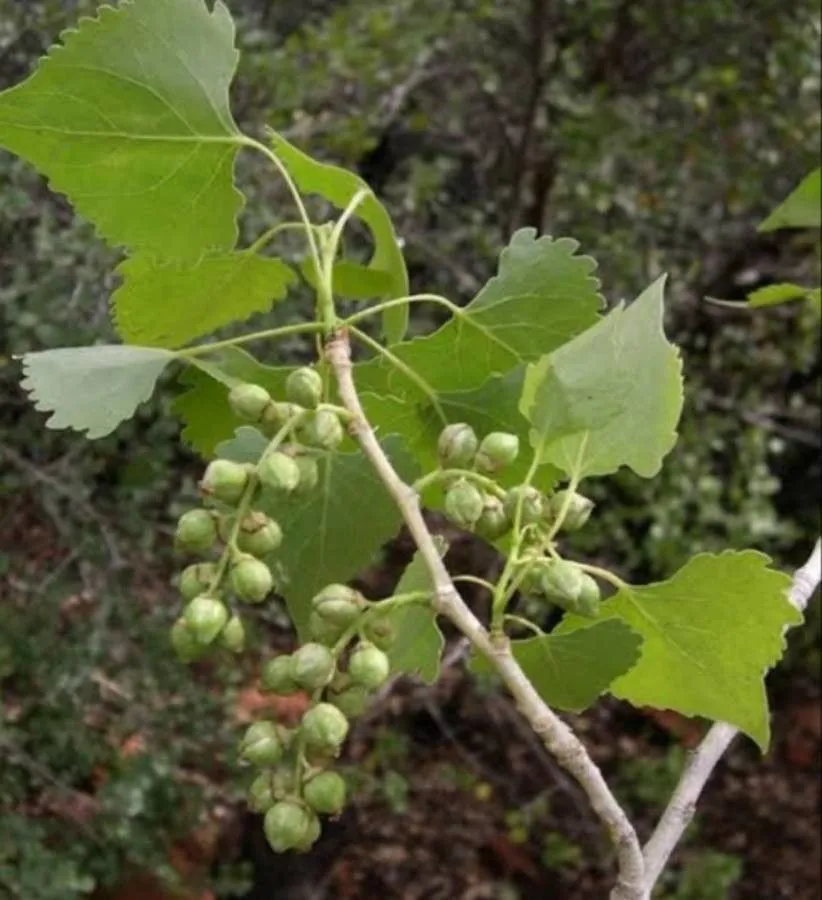
Author: S.Watson
Bibliography: Proc. Amer. Acad. Arts 10: 350 (1875)
Year: 1875
Status: accepted
Rank: species
Genus: Populus
Vegetable: False
Observations: NW. U.S.A. to NW. Mexico
Fremont’s cottonwood, scientifically known as Populus fremontii, is a prominent and resilient tree species indigenous to the riparian zones of the northwestern United States and northwestern Mexico. This species was well-documented in the botanical literature in 1875 by S. Watson in the proceedings of the American Academy of Arts. Fremont’s cottonwood thrives in moist environments and is predominantly found along streams, rivers, and floodplains where groundwater is accessible.
Belonging to the Salicaceae family, this deciduous tree can grow to impressive heights, often reaching up to 30 meters. Its broad, triangular, and toothed leaves provide a dense canopy, which offers essential shade and habitat for a variety of wildlife. The tree’s bark, characterized by deep fissures and a grayish hue, adds to its distinctive appearance, making it easily recognizable.
Fremont’s cottonwood plays a crucial ecological role, stabilizing stream banks and preventing soil erosion with its extensive root system. This not only supports the local ecosystem but also enhances water quality by filtering sediments and pollutants. Moreover, its foliage serves as a primary food source for caterpillars and other herbivorous insects, which in turn support a diverse array of bird species.
Historically, indigenous communities have revered Fremont’s cottonwood for its medicinal properties and as a resource for crafting tools and shelters. Today, the tree remains a significant horticultural and ecological asset, appreciated for its rapid growth and ability to regenerate from cuttings, which makes it an excellent choice for reforestation and habitat restoration projects.
In summary, Fremont’s cottonwood (Populus fremontii) is not only a majestic and vital component of the riparian landscapes in the northwestern U.S. and Mexico, but it also embodies a rich legacy of environmental and cultural importance.
Eng: fremont’s cottonwood, cottonwood, fremont cottonwood
Spa: álamo
En: Fremont’s cottonwood, Cottonwood
Es: Álamo
: Fremont cottonwood
© copyright of the Board of Trustees of the Royal Botanic Gardens, Kew.
© copyright of the Board of Trustees of the Royal Botanic Gardens, Kew.
© copyright of the Board of Trustees of the Royal Botanic Gardens, Kew.
Taken Aug 13, 2019 by that’s someguy (cc-by-sa)
Growth form>: Single Stem
Growth habit>: Tree
Growth rate>: Rapid
Ph maximum: 8.0
Ph minimum: 6.0
Family: Myrtaceae Author: (F.Muell.) K.D.Hill & L.A.S.Johnson Bibliography: Telopea 6: 402 (1995) Year: 1995 Status:…
Family: Rubiaceae Author: Pierre ex A.Froehner Bibliography: Notizbl. Bot. Gart. Berlin-Dahlem 1: 237 (1897) Year:…
Family: Sapindaceae Author: Koidz. Bibliography: J. Coll. Sci. Imp. Univ. Tokyo 32(1): 38 (1911) Year:…
Family: Asteraceae Author: A.Gray Bibliography: Pacif. Railr. Rep.: 107 (1857) Year: 1857 Status: accepted Rank:…
Family: Fabaceae Author: Medik. Bibliography: Vorles. Churpfälz. Phys.-Ökon. Ges. 2: 398 (1787) Year: 1787 Status:…
Family: Aspleniaceae Author: (Cav.) Alston Bibliography: Bull. Misc. Inform. Kew 1932: 309 (1932) Year: 1932…